
Dogs often experience ear issues: mites, yeast, and bacteria can cause symptoms such as constant ear scratching, headshaking, a strange yeast smell, red ears or a black ear discharge. It is less common to see fleas INSIDE the ears, although dogs can have heavy infestations on the rest of the body.
This article will outline what might be causing your dog’s ear discomfort and address how to treat fleas, ear mites, and ear infections.
Do fleas get inside a dog’s ears?
It is very uncommon to see fleas INSIDE a dog’s ears. Fleas tend to live in areas of thicker hair, so it’s unlikely to find them inside the ear canal. You are more likely to see them hopping on and off your dog’s head, neck, and back. To confirm, read our article: easy ways to tell if your dog has fleas or find out how to get rid of these fleas.
So if fleas don’t congregate inside my dog’s ears, then what do I see in there?
Does my dog have fleas, ear mites, or something else?
Fleas: Fleas don’t usually live inside ears. With a heavy flea infestation on the rest of the body, you might see the occasional flea that has jumped inside the ear, but this is not a normal finding. Learn how to get rid of these fleas.
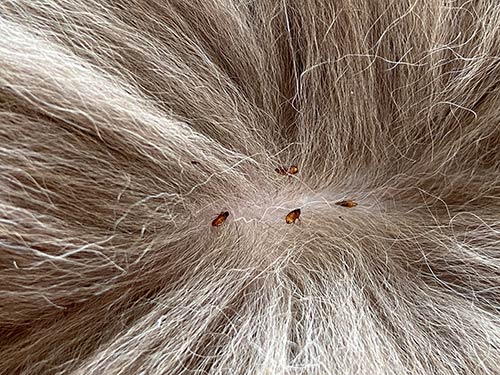
Ear mites: Ear mites are tiny parasites, only about 1-2 millimeters in size. They are not visible to the naked eye as they are just large enough to be seen using a microscope. When viewed under a microscope, ear mites look somewhat like a tick. And just like a tick, they feed on your dog’s blood, ear wax, and oils from the skin… Gross! Learn more about ear mites.
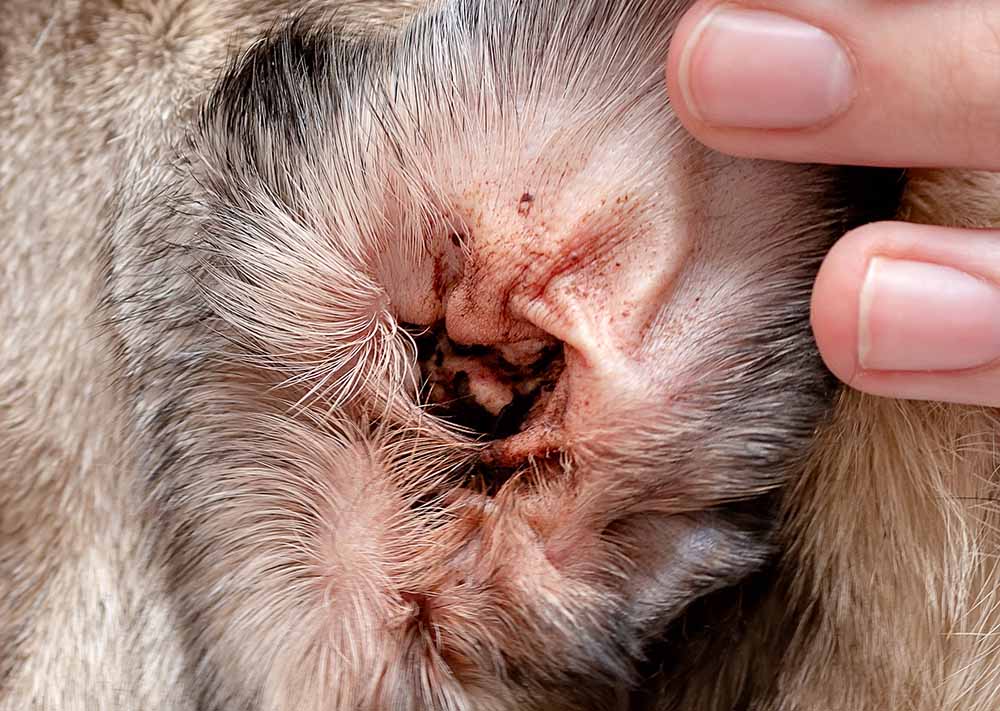
Ear mite symptoms include:
- Itching and scratching at the ears more than normal
- Head tilt
- Scabs or wounds
- Dark brown or black crusty debris
Ear infections: ear infections are a daily occurrence in my practice – and in most veterinary offices. Many veterinarians see multiple pets with ear infections each day.
Ear infections, they may be caused by a mixture of bacteria and yeast. Yeast is often what gives the ears a distinctive “cheesy” smell. Mites typically do not give off an odor like this. Symptoms of yeast or bacterial ear infections are often very similar to those seen with mites:
- Itching and scratching at the ears
- Head tilt
- Red, yellow, or brown waxy discharge
- Loss of balance or incoordination
- Red, irritated skin inside the ear canal
- A distinct “cheesy” smell
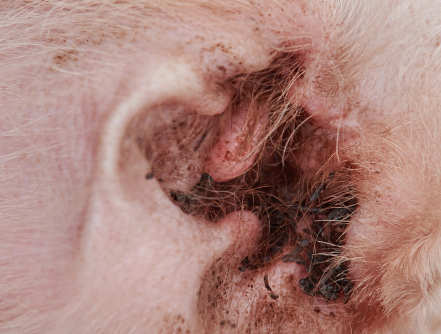
You should make an appointment with your veterinarian if you notice any of the above symptoms. While there are over-the-counter ear-cleaning solutions and flea treatments, it is best to work with your vet to make an appropriate treatment plan specific to your dog. There are an overwhelming number of products available on the market – let your veterinarian help you!
So how do I know if it is fleas, mites, or an infection?
The best way to tell if your dog has ear mites or a yeast infection is to look at an ear swab under the microscope. Your veterinarian will gently stick a small swab into each ear, wipe the wax on a microscope slide, and view it under the microscope.

This ear swab is critical to determine the cause since we want to ensure we treat the ears appropriately. For example, we do not want to use just an antibiotic if the ear swab shows bacteria and yeast – we would need an antifungal medication to treat the yeast component of the infection.
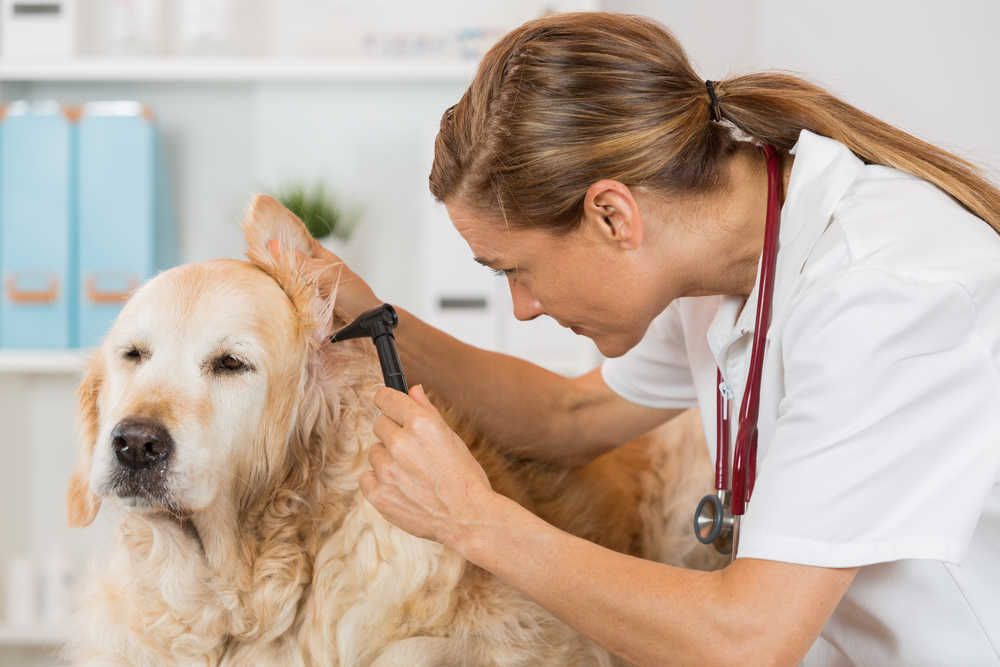
Using an otoscope, your veterinarian will also look very closely inside your dog’s ears. It’s essential to ensure the eardrum is intact (not ruptured), as some medications can worsen the situation if the eardrum is ruptured. The otoscope also allows your vet to ensure nothing is stuck inside the ear like a grass blade or foxtail.
Treatments for ear problems
It is best to have your dog’s ears evaluated by your veterinarian to ensure the most appropriate treatment. If you want to give your dog some immediate relief, you can use a non-medicated over-the-counter ear cleaner once daily until you can get an appointment. Do not put coconut oil or apple cider vinegar in your dog’s ears, which can cause further irritation or worsen the infection.
1. How to get rid of fleas
Over-the-counter: Frontline is a spot-on treatment used in dogs to treat and prevent fleas. It is a small amount of liquid applied to the skin (usually between the shoulder blades) once a month. Make sure you are ONLY using this on dogs, NOT cats. Products that contain permethrin are severely toxic to cats.
Veterinary options: Trifexis, Simparica, Capstar, Revolution, Nexgard, and Bravecto are all prescription products. Speak to your veterinarian about the best choice for treating your dog’s flea infestation. Note that some flea and tick medications are combined with monthly heartworm prevention.
Environment: It is critical to treat the environment for fleas as well. It is estimated that 90-95% of fleas in the house are NOT on the pet but in the carpet, bedding, and other soft and warm areas. Adult fleas on the dog will deposit eggs on the host (in this case, your dog). These eggs can fall off into the carpet and surrounding environment and hatch into larvae. Over the next 1-2 weeks, the larvae develop into their next stage – the pupae. These pupae mature in a cocoon and develop into adult fleas. Warmth, vibration, and even carbon dioxide (meaning a breathing host is nearby) all stimulate the flea to emerge from the cocoon.
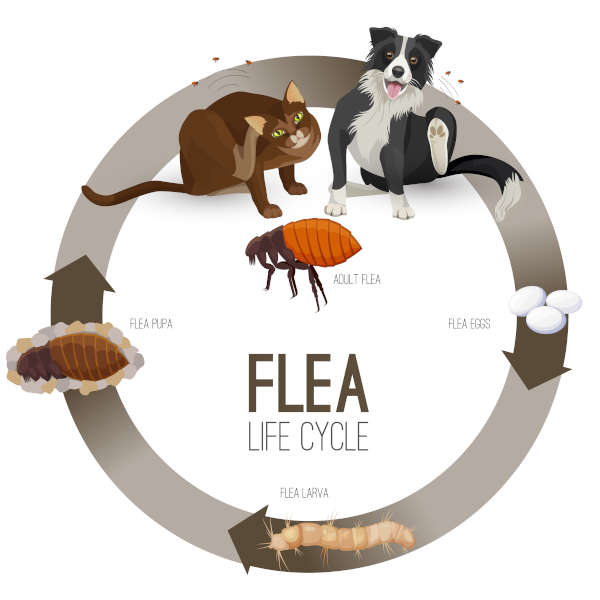
While your dog is being treated for fleas, you must also adequately clean the environment. Vacuuming daily with a beater-bar brush attachment is one way to remove the pupae and fleas from the carpet. Be sure to dispose of the vacuum bag or clean the container immediately, so the fleas are not staying in the vacuum. You can also steam clean bedding and carpet weekly.
2. How to remove ear mites
If your veterinarian diagnoses ear mites in your dog, various treatment options are available. Revolution, Simparica, and Bravecto are all prescription products that kill ear mites. Remember, these medications are often multipurpose and address other parasites as well. It is best to work with your veterinarian on which specific product is most appropriate for your dog.
3. How to help your dog with ear infections
Remember to treat an ear infection adequately, your veterinarian needs to know if there are bacteria, yeast, or both. In complicated or chronic ear infections, your veterinarian might need to send a swab to the laboratory for culture and sensitivity. This means they grow the bacteria in the lab and determine exactly which antibiotics it is responsive to. This typically is not necessary for simple, uncomplicated ear infections.
Your veterinarian will likely prescribe an ear cleaner and a topical medication targeted for yeast and bacteria. The ear cleaner helps loosen the wax so that the medication penetrates the ear better. Your veterinarian will show you how to clean and medicate the ears. A typical ear infection treatment lasts about two weeks. Learn more about common ear infections in dogs (with pictures & vet advice).
Disclaimer: This website's content is not a substitute for veterinary care. Always consult with your veterinarian for healthcare decisions. Read More.


Be the first to comment